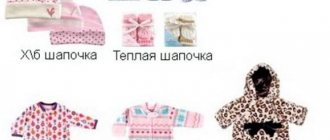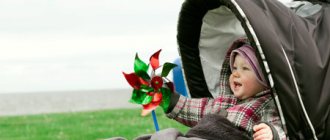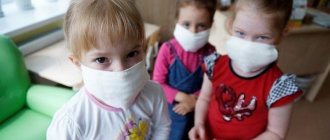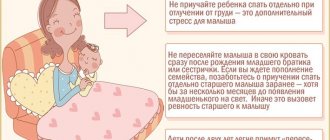When can you take a walk with your newborn if he was born in the summer?
Summer is the most favorable time for walking. It's warm and sunny outside, so I really want to introduce the baby to the world. When can a newborn finally go for a walk after the maternity hospital, if the weather outside is wonderful? Take your time, wait at least 7 days before going outside for the first time.
Good to know
Drive away annoying flies and mosquitoes from the body and especially from the baby’s open face. If insects are very annoying, use a mosquito net. Some strollers already have it included, while for others you can buy it separately.
Remember that the bright summer sun, which makes the baby’s parents so happy, can be dangerous for him. Do not go out for a walk in the daytime, when the air gets very hot and the walls of the stroller instantly become hot. Go for your first walk with your newborn in the morning or evening, when it is not so hot outside. In the meantime, make sure that your baby’s skin is not exposed to direct sunlight.
Walking in the summer
Each time of year has its own characteristics of walking with a baby already adapted to the street. Here's what you need to consider in the summer: 1 You can't stay outside for a long time in hot sunny weather . A baby can get heatstroke from prolonged exposure to heat. In case of wind or rain, even if it is warm, on the contrary, you will catch a cold. 2 In hot weather, you should not walk during the day; it is better to do it in the morning or evening . If we talk about how long you can walk with a newborn in the summer, then this time depends on weather conditions and the condition of the baby. For infants up to a month old, no more than an hour at a time, and it is better to limit the very first walk to 20 minutes. 3 The baby's clothes should only be made from natural, light-colored fabrics . The optimal suit for a summer walk consists of a light jumpsuit, a sleeveless dress or bodysuit, and a vest with rompers.
When walking with a newborn in a stroller, the child can be placed in a cocoon diaper or a regular diaper, and he will sleep comfortably in it. Read here how to properly swaddle a baby.
Konovalova G.A., pediatrician, children's city hospital No. 17, Sormovsky district, Nizhny Novgorod
A walk in the fresh air is an integral aspect of peace of mind not only for the child, but also for the mother. After walks, the baby sleeps well, eats, and is less capricious.
This has a good effect on the mother’s mental balance. In addition, walking with a stroller helps mothers quickly lose excess weight gained during pregnancy.
If you are walking with a sling, a T-shirt, a diaper, or a Panama hat are enough, because the baby will be warm from the mother’s body. 4 Must have a Panama hat, scarf or cap , regardless of whether the baby is walking in a stroller, sling or in his arms. It is very easy for a newborn's head to overheat, so the headdress should be light, preferably white, to reflect all the sun's rays. The sling should also be light.
The optimal air temperature for walking with a newborn is 20-25 C°.
List of things to take with you for a newborn:
When packing your bag for a walk, do not forget to take a mosquito net with you for a restful sleep for your baby, especially if you are walking near bodies of water
- a bottle of water;
- spare diapers;
- diapers for newborns;
- something in case of a sudden change in weather - a long-sleeved blouse, a blanket;
- pacifier;
- toys, usually a newborn sleeps during walks, but if he wakes up and cries, he needs to be distracted with something.
When should you start walking your newborn if he was born in winter?
The answer to the question of what day to take a walk with a newborn in winter greatly depends on the weather. Firstly, you should not go outside if the thermometer drops below -10 °C. It is advisable to take into account both humidity and wind, i.e. pay attention not only to the actual temperature, but also to the “feels like” point in the weather forecast. Secondly, do not go for a walk if there is heavy snow outside, especially with a stroller: pushing it along unclean paths is even more fun. Thirdly, wait out the ice at home: you shouldn’t tempt fate when there is a risk of falling and dropping your child.
Good to know
Often on winter walks, mothers cover their babies’ faces with a scarf. This is the wrong decision: the moisture in the baby's exhalations condenses on the fabric, making it cold and wet, and the skin can freeze faster. Don't worry, your baby's respiratory system can cope with the frosty air.
If the weather is favorable to you, you can go outside with your baby a couple of weeks after arriving from the maternity hospital. But if it gets bad in the next few days, stay home. Walking with newborns is not a training course that cannot be interrupted.
Why go for a walk
A baby brought from the maternity hospital seems fragile and defenseless. And outside there is noise, exhaust fumes, drafts and infections. Given such dangers, is it even possible to walk with a newborn? Not only is it possible, but it is also necessary. The main reasons for this are:
- The baby needs a flow of oxygen. If there is not enough of it, the sleep of a 1-2 month old child and his appetite will worsen. And even in a big city there is more oxygen on the street than in an apartment, even with open windows.
It is better to enrich the baby’s body with vitamin D in the morning and evening. - The baby's thermoregulation is just developing, and differences between temperatures help regulate it. While walking with a newborn, it hardens, which strengthens the immune system.
- For the development of the skeletal and nervous systems, vitamin D3 is needed, which the body synthesizes under the influence of ultraviolet radiation, i.e. sun . Vitamin D is enough even in cloudy weather.
Walking with the newborn is also beneficial for the mother. Walking can help you quickly lose weight after giving birth. At this stage, immediately after childbirth, heavy loads are contraindicated for her, but walking will be just right. Plus you can meet other mothers.
When can you go for the first walk with your newborn if he was born in spring or autumn?
The weather in the off-season is deceiving, and this is its main danger: when you left the entrance, it was warm and sunny, by the time you reached the park the sky was overcast and the wind rose. Walking with newborns at this time requires special preparation. Dress your child in such a way that you can quickly remove one layer of clothing if it gets warmer. Bring a blanket with you in case it gets unexpectedly cold. You can plan your first trip outside a week or a week and a half after the baby is born.
Good to know
There are special rain covers for strollers, and this is a very useful invention for walks in the off-season. But remember: a raincoat is only an emergency measure against unexpected bad weather that will allow you to reach the entrance. You can’t walk for a long time under a raincoat - it creates a greenhouse effect in the stroller, increasing temperature, humidity and limiting the flow of fresh air.
Assess the weather soberly! Don’t go for a walk if it’s nasty autumn rain outside. Stay home if there are spring streams flowing along your favorite walking paths right now. Remember that you need to take care not only of the baby’s well-being, but also of the health of his mother. If you miss a few trips outside, nothing bad will happen. But if you go for a walk in spite of all the elements, and then get sick, many things may be at risk, in particular breastfeeding.
Summer walks with a newborn
When should you start?
The first trip outside with a healthy baby can be made within 5-7 days after discharge. There is no need to take a long walk with your baby for the first time, even if the weather permits. 10 minutes is enough for your first acquaintance with the street. Gradually increase your walking time with each subsequent outing.
On good summer days, you can allow your child to sleep and play in the yard all day. They bring the fidget home only for eating.
What if it's hot?
If the air temperature exceeds 30 degrees, walking with a newborn is strictly prohibited. The child's thermoregulation mechanisms are not sufficiently developed; the baby can easily overheat. It is better to postpone your walk until the morning or evening hours.
If the thermometer scale reaches 25 degrees Celsius, you need to follow some rules.
- choose light, thin clothes of good quality for your child;
- to avoid overheating, do not swaddle your baby;
- to prevent the baby's back from sweating, the mattress should not contain artificial materials;
- It is worth taking a spare diaper with you so that the baby is not wet;
- do not deny your baby breast milk and water. Remember that breast milk replaces food and drink for the baby.
Possible troubles
Overheat
If simple rules are not followed, long summer trips can result in unpleasant situations for the baby. Often the baby overheats, and the first manifestations are diaper rash and heat rash.
The rash caused by prickly heat causes anxiety to the baby and may interfere with sleep and the general condition of the child. The baby becomes capricious and irritated. With diaper rash, there is pain, loss of appetite and the child’s well-being.
To avoid this, you need to carefully monitor the child’s behavior while walking. When overheated, the baby becomes restless, begins to breathe quickly, and a blush appears on the face. The baby often asks for breastfeeding or water. If you take your temperature at this time, it will be elevated.
Heatstroke, sunstroke
Sunstroke in infants occurs when the baby is under the scorching sun. The child's body is not able to properly regulate temperature, so it overheats very quickly. Heatstroke occurs in babies who have been exposed to elevated temperatures, for example, tightly wrapped in a stroller.
In case of severe overheating, the child’s temperature rises to 38 degrees. The baby’s well-being is disturbed, the child screams or, conversely, becomes lethargic and apathetic. In serious cases, vomiting and loss of consciousness may occur.
In case of heat and sunstroke, you must urgently call an ambulance. Before the doctors arrive, you need to move the child to the shade, undress, and wash his face with water.
How long can you walk with a newborn?
You shouldn't go outside for a long time right away. The first walk with a newborn should last no more than 15 minutes in the summer or in good weather in spring and autumn. In winter it is better to start with 5 minutes. Gradually increase the duration of your walks by 10–15 minutes.
Good to know
At first, your trips outside will be very short. You can spend more time rolling out and preparing the stroller, putting your baby in it, and then putting it back “in the parking lot” than on the walk itself. To solve this problem, temporarily abandon the stroller and take your baby outside in a sling.
Do not listen to advice that there is a minimum duration of walks that must be maintained. Walk as much as you feel comfortable! some mothers go out with their baby for only an hour, others take a couple of exercises a day for a total duration of three hours or more. Choose a mode that is convenient for you and your child.
In bad weather, walks with newborns can be moved from the street to the balcony. During the first few “walks”, do not leave your baby; later you can start leaving him alone on the balcony under the supervision of a baby monitor. When the child learns to roll over, walks on the balcony should be stopped - he may fall out of the stroller.
Children's wardrobe by age and season
Thermoregulation of newborns is still imperfect, so it is important to prevent the baby from overheating or overcooling. The universal principle is to dress a child in the same way as an adult, plus one more layer of clothing. That is, if a mother, going out for a walk, puts on a T-shirt, a thin sweater, a jacket and a hat, the child should wear a vest and rompers made of thin knitwear, another thin overalls, a suit made of warm material (fleece or wool) and winter overalls, and under put on a warm cap.
| Child's age | Winter | Spring/Autumn | Summer |
| Child up to 6 months |
|
| For warm weather:
|
| Children 6 months and older |
|
| If it's warm:
|
What are the dangers of walking with newborns?
Thinking about the benefits of walking, many mothers forget that they carry a number of dangers:
- Hypothermia or overheating. Due to the wrong choice of clothing, sudden changes in weather and other factors, the baby may freeze or overheat. Be sure to check how your baby is feeling every 10 minutes.
- Sleep disturbances. Children often sleep during walks. Very little babies fall into “anabiosis” due to the unusual temperature and increased oxygen concentration, but later the baby may develop a conditioned reflex: the street and gentle rocking are necessary for sleep. This situation is potentially dangerous because it will be difficult to put the child to sleep at home, and he will begin to give you sleepless nights. Make sure this doesn't happen. When walking with your older toddler, communicate more with him, and at home strictly follow his sleep schedule.
- Difficulties with feeding. Newborns often want to eat, but doing this outside can be problematic, especially in winter. Plan walks between feedings, and if you feed your baby right before going out, don't forget to give him a chance to burp.
- Difficulty changing a diaper. Changing a diaper on the street today is not a problem. Simply rip the side seam, remove and close the used diaper, wipe baby's skin with huggies, then put on a new diaper. But this scheme only works in good weather in the summer. You can't change your baby's clothes when it's cold outside!
If during a walk you see that the child is capricious, crying, or feeling unwell, do not torture the baby and return home. Even if you didn’t make it until the allotted time.
When to release a child
Is there a law prohibiting children under a certain age from being allowed to go outside alone?
“There is no federal law that would not allow children to be on the street without adult supervision,” said the office of the Commissioner for Children’s Rights under the President of the Russian Federation, Pavel Astakhov.
— There are only regional laws on this matter. Thus, in Kuban, children under seven years old are prohibited from leaving home unattended, and a curfew is established for teenagers. It turns out that formally in Russia, babies even from the maternity hospital have the right to get home on their own.
At what age is it safe for children to leave home alone?
“It depends on the place where the family lives, on whether there is a road nearby,” says Boris Altshuler, chairman of the board of the public organization “Children’s Right.” - If, like Pushkin: “The baby has already frozen his finger, he is both sad and funny, and his mother is threatening him through the window...” - then it’s one thing, from the age of seven you can safely let him go into the yard. You should not be younger than this age. But this is only in the immediate vicinity of the house.
Who is responsible for a child when he is on the street unattended?
Until the age of 18, responsibility for the child lies entirely with the parents. Based on this, we must decide whether he should be given additional freedom, whether he can cope with it, whether he can control his own safety.
At what age should children be sent to school?
“In my opinion, children are ready to move independently along a familiar route at the age of 10-11,” says Viktor Panin, chairman of the All-Russian Society for the Protection of the Rights of Consumers of Educational Services. “Sometimes you can let one go earlier, but at the same time have strict control over it. Now almost all schoolchildren have phones. And it will be correct if, having achieved the goal, the child immediately calls his parents and reports: I’ve arrived, everything is fine.
Can a child go home from kindergarten alone or with his older brother?
The heads of many kindergartens require that only adults pick up children from groups and do not let pupils go even with older brothers or sisters if they are under 18 years old. Experts believe this is unfounded.
“Of course, no one will let a kindergartener leave the gate alone, no matter how the law is formulated, but there are simple human rules,” explains Alshuler. - But there is another extreme. In our country, even in Drebodan, a drunken father will be given his baby, although in Europe they would call the police - that’s the law. And, probably, they would have done the right thing. Therefore, I don’t see anything criminal in younger children being taken away by older ones, especially if they are not a couple of years apart, and the teacher has a corresponding statement from the parents on his desk.
Is it possible to leave home alone?
Life is a striped phenomenon, as we know. There are different families, there are all sorts of situations. And many kids have to get used to making do on their own. Simply because there is no free grandmother nearby, and mom needs to go away on business. It’s not possible to take your child with you every time. Experts advise one thing: when developing independence, do not forget about the risks. If in an apartment it is possible to remove from the access area all objects potentially dangerous to the baby, then it is impossible to clean the yard or street in this way.
“If we provided all mothers in need with home-based work, as they do in France, we could require parents to provide round-the-clock child care,” says Boris Alshuler. “But we don’t have that yet.” Because of this, children are sooner or later left alone. And here everything is left to the parents, their perception of the children’s readiness for independent life. But I myself would not advise leaving preschoolers unattended. After seven years, children can already spend some time on their own.
How to dress your baby for a walk?
For the previous nine months, the baby lived in a warm and, most importantly, constant climate. He had no place to practice thermoregulation, and now it is difficult to cope with temperature changes from room to room. So you have to help him with this. When going for a walk with your newborn, follow these rules:
- Dress your baby in layers, and instead of one thick one, it is always better to choose two thin ones. If your child overheats, simply remove the outermost clothing. And in case your baby gets cold, take a blanket with you - it will become a spare layer.
- Don't wrap your baby up too much. To ensure the necessary comfort while walking, follow a simple formula: the child should wear one layer more clothes than his mother. Don't forget that the envelope and stroller cover also count.
- When going for a walk with a newborn, some mothers carefully dress the baby, and then begin to get ready themselves. Don’t do this: when a baby lies in street clothes in a warm apartment, he quickly overheats.
General rules
Whatever the time of year, when going for a walk with a newborn, you need to adhere to some rules:
Before a walk, it is better to feed the baby already dressed for the street, because... He may fall asleep while feeding
- The stroller should be comfortable, with shock absorbers, a comfortable mattress made of natural materials, and should correspond to the time of year. How to choose a winter or summer stroller, read here.
- You need to walk away from noisy roads and cars - in parks, squares, protected courtyards, and children's playgrounds.
- When going for a walk, the mother needs to get dressed first, and then the baby, otherwise he may overheat before the walk or sweat.
- What time is best to walk with a newborn is decided depending on the weather and when he eats - walks should be between feedings.
- In bad weather, it is not necessary to deprive the child of fresh air; you can “take a walk” on the balcony, the main thing is not to put the child where there is a draft.
Serbina E.V., pediatrician, Life Medical Clinic, Krasnodar
If the newborn, like his mother, feels good, and the weather is excellent, then it is permissible to start walking at least immediately after you find yourself at home after the maternity hospital.
If the baby’s health is weakened, or he was born prematurely, then your pediatrician will determine the possibility of walking.
You cannot go for a walk when there is severe frost, wind, heat or other unfavorable conditions . The restriction for going outside will be the baby's illness, including a mild cold. A premature baby is especially vulnerable, so questions about when you can walk with a newborn in such a situation should be discussed in detail with your pediatrician. The decision depends on individual characteristics. Read more about the Apgar score in newborns here.
According to Dr. Komarovsky, you need to spend as much time as possible outside with your child. After all, various pathogenic bacteria accumulate in apartments and houses, including those that can cause allergies in infants. In the fresh air, the lungs are cleansed.
In addition, there are no sources of ultraviolet radiation, so important for the development of a newborn baby. Well, for mom, the lack of walks is a limitation of physical activity and opportunities for rest.
How to make sure that your baby is comfortable on a walk?
Many mothers and, it seems to us, all grandmothers without exception, are very afraid that the baby will freeze. At the same time, they usually have no fear that the baby will be hot. But in vain: overheating is more dangerous for a child’s body than hypothermia.
On your first and subsequent walks with your newborn, periodically check how he is feeling. Touching a baby's nose or forehead is completely pointless - the temperature of exposed areas of the body greatly depends on weather conditions. There is a more reliable way: put your hand under your baby’s clothes (if it’s cold outside, warm your hand first) and touch the back of his neck:
- Cabbage Rule
Dress your baby in layers, and instead of one thick one, it is always better to choose two thin ones. If your child overheats, simply remove the outermost clothing. And in case your baby gets cold, take a blanket with you - it will become a spare layer.
- Rule "+1 layer"
Don't wrap your baby up too much. To ensure the necessary comfort while walking, follow a simple formula: the child should wear one layer more clothes than his mother. Don't forget that the envelope and stroller cover also count.
- The “Mom gets dressed first” rule
When going for a walk with a newborn, some mothers carefully dress the baby, and then begin to get ready themselves. Don’t do this: when a baby lies in street clothes in a warm apartment, he quickly overheats.
Walking in winter
In winter, it can be more difficult to organize regular celebrations. Severe frosts, prolonged snowfalls, and ice can interfere with a newborn's walk.
Here's what you need to consider in winter: 1 You need to “pack” your baby with three layers of clothing. Let's say it will be a thin blouse with pants, a fleece overall, a winter insulated envelope or overalls.
A thin one should be worn under a warm hat. It is important that the child's ears and neck are covered. The materials for the inner garments should be natural, but the outer layer of the overalls can be synthetic, impervious to cold, wind and moisture. 2 If the baby turns red and sweats, it means he was dressed too warmly. A cold nose is a signal of hypothermia. How long to walk with your newborn in winter depends on his well-being and the weather.
The first time, the residence time should not exceed 20 minutes, with a gradual increase.
Svechina E.A., pediatrician, SM-Clinic on Danube Prospekt, St. Petersburg Many mothers ask: is it possible to replace a walk with sleep on the balcony? You can only if you can’t go for a walk due to bad weather.
In any case, there is less oxygen in the apartment than outside. If it faces a busy road, then this is not an option at all.
But the best places for walking with a child and his healthy sleep are parks planted with trees: where birds chirp and the air is saturated with oxygen.
3 The mother herself should also be dressed warmly and comfortably. You will have to do without heels, tight clothes, avoid slippery sections of the road, and walk slowly. 4 You need to have a warm blanket with you to protect your baby from frost and sudden wind and snow . To avoid hypothermia, it is better to go out twice a day for short periods of time than once for a long time.
As for the off-season, you need to walk with your newborn, as in other times of the year. That is, dress according to the weather, monitor your health, and avoid hypothermia or overheating.
General walking rules for children of all ages
Summer
- Avoid walking between 12:00 and 16:00 when the sun is very active.
- Protect your child's head from the sun. A headdress made of light fabric is required.
- Take drinking water with you.
- Try to use disposable diapers less in hot weather.
- Protect children from mosquito bites with mosquito nets and age-appropriate repellents.
- Avoid active games in the sun.
Spring/Autumn
- Outerwear should reliably protect from wind and precipitation.
- We protect our hands from the cold with gloves or mittens.
- Feet should always be dry and warm.
- Take raincoats with you.
Winter
- Feed your baby before going for a walk and he won't be cold.
- Use the principle of layering in clothing. Several thin layers warm better than one warm suit worn over underwear.
- Outerwear should not be tight or heavy.
- Do not cover your child's mouth and nose with a scarf. Damp air from breathing can cause a cold.
- Dress yourself first, and then dress your child so that he does not sweat.
- Ensure that your outerwear fits snugly around your head, neck, and wrists.
- It is better to divide one long walk into two short ones. This will reduce the risk of hypothermia.
Properly organized walks will bring your baby a good mood and good health!
Features of walking with children after one year
The same temperature regime for walks is recommended as for children under one year old. Clothing is selected taking into account the purpose of the walk. For example, it is worth putting pants or overalls on your child if he will play in the sandbox.
It is better to always have replacement diapers, wet wipes and a spare set of clothes with you. In winter - spare mittens.
Choose clothes made from natural materials that are loose and do not restrict movement.










